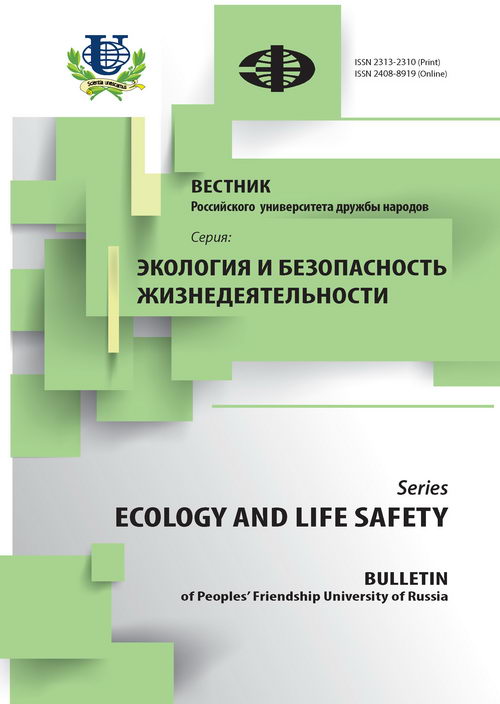Влияние промышленных сточных вод на загрязнение Персидского залива (на примере промышленной зоны Южный Парс, Иран)
- Авторы: Акбарпур Д1
-
Учреждения:
- Санкт-Петербугский государственный университет
- Выпуск: № 3 (2014)
- Страницы: 83-93
- Раздел: Статьи
- URL: https://journals.rudn.ru/ecology/article/view/12560
- ID: 12560
Цитировать
Полный текст
Аннотация
Исследование проведено для решения одной из актуальных экологических проблем региона. Изучен сброс неочищенных или частично очищенных сточных вод в прибрежные воды Персидского залива. Изучено воздействие загрязняющих сточных вод на качество прибрежных вод и экосистемы на протяжении 45 км побережья Персидского залива и в радиусе 10 км от берега. Качество сточных вод оценивалось в течение трех месяцев в соответствии с национальными стандартами Ирана и требованиями ROPME.
Ключевые слова
Список литературы
- Akbarpour D. Site selection of residential area around Pars special economic energy zone and its environmental impacts using GIS.M. Sc Thesis in Environmental Science. Branch of Pollution. Islamic Azad University. Science and Research. 2008. p. 87-114.
- Buchholz R.A. Principles of Environmental management. The Greening of Business, 2 prentice - Hall, London, UK. 1998.
- Calamari. D. Naeve. H. Review of pollutionin the African aquatic environment. Committee for Inland Fisheries of Africa (CIFA) Technical paper No.25, 1994. FAO, Rome, 118.
- Chindah, A.C., A.S. Braide and O.C. Sibeudu. Distribution of hydrocarbons and heavy metals in sediment and a crustacean (shrimps-Penaeus notialis) from the bonny/new Calabar river estuary, Niger Delta. Ajeam-Ragee, 2004. V. 9. p. 1-14.
- Dabiri M. Handbook of Environmental Pollution. Tehran. Iran Press. 2008. №. 5. P. 62-69.
- Department of Environment. Boushehr Province. Marine Environment, Boushehr. Iran 2011-2012.
- Department of Biology McGill University of Canada Montreal, Quebec Canada H3A 1B1. 2013. http://Bilogy.mcgill.ca/faculty/Gregory_eaves.
- DWF.WRC, South African quality management series. Procedures to Assess effluent discharge Impacts. WRC Report No. TT 64/94. Department of water Affairs and forestry and water research commission. Pretoria. 1995.
- Firouz E. A Guide to the Fauna of Iran. Firouz E., Dahi M. Academic Press. Tehran. 2000. № 1. P. 122-414.
- Iranian Fisheries Research Center Report Series and Government regulatory approvals. Tehran. Iran. 2010. P. 71-78.
- Jon G. Sutinen and et al, Handbook on Governance and Socioeconomics of Large Marine Ecosystems. University of Rhode Island Press. U.S.A. 2006. p. 1, 32-34.
- Kanin A. Fishes of the Persian Gulf. Bushehr Encyclopedia Academic Press. Tehran. Iran. 2010. №. 1. P. 23-182.
- Larsen J. Dead Zones Increasing in World’s Coastal Waters, Eco-Economy. Nutrient pollution of coastal ecosystems, Earth Policy Institute regional office for north America. Mexico, 2004.
- Lloyd B. and Helmer R. Surveillance of drinking water quality in rural areas. Longman Scientific and Technical, New York; Wiley. 1992. p. 34-56.
- Magnonian H. Handbook of Protected Areas of Iran. Environmental protection organization Press. 2000. № 2. P. 105-109.
- Miranzadeh M. Handbook of Designing Wastewater collection system, Hafiz Press. Tehran. Iran. 2007. № 2. P. 172-193.
- Monsavi M. Handbook of Urban Wastewater, Tehran University Press. Tehran. Iran. 2003. № 3. P. 13-68.
- Morris J. Handbook of Formation history of the city to the Industrial Revolution, translated by R. Rezazadeh. M.: University of Science and Technology Press. Tehran. Iran. 1998. № 8. p. 184.
- National Iranian gas Company. Report Series (NIGCI/R/195002 Q). Tehran. Iran. 1992& 2001. P. 205-211.
- National Institute of oceanography, Persian Gulf Ecological Research, Report Series and Government regulatory approvals. Tehran. Iran. 2009-2010. P. 161-174.
- Nicholas P. Handbook of water and wastewater treatment technologies. Press. U.S.A, Boston, Washington, 2002 № 1. P. 33-37, 446-456.
- Okoh A.I., Odiadjare E.E., Igbinosa E.O., Osode A.N. Wastewater treatment plants asasource of microbial pathogens in the receiving watershed. Afr. J. Biotech. 2007. 6(25). p. 2932-2944(13).
- Рrice A.R., Robinson J.H. The 1991 Gulf War: Coastal and Marine Environmental Consequences. “Marine Pollution Bulletin” 1993, V. 27. p. 27.
- Quality Assurance project plan for Environmental Monitoring and Measurement Activities Relating to the Resource Conservation and Recovery Act (RCRA) & Underground Injection Control (UIC) Fiscal 2009.
- Rasouli M. Project of Coastal protected areas. Iranian organization of Ports and Maritime Office of Marine Safety and Protection. 2006.
- Research Institute of Petroleum Industry Environmental Pollution. Tehran. Iran. 2007-2009.
- Regional organization for the protection of the Marine Environment (ROPME). Manual of oceanographic observation and pollutant analysis methods. Kuwait. 1978. Report. 2010. P. 220-226.
- Shariat М., Мonavari М. Introduction to Environmental Impact Assessment, the organization of Environmental Protection Press. Tehran. Iran. 2006. 1994. № 3. р. 43-51.
- Shekuhi H. New perspectives in urban geography. Tehran samt Press. Tehran. Iran. 1994. № 1. р. 142.
- Standard method for the examination of water and wastewaterquality. Assurance Manual and Standard Operating Procedures. by American Public Health Association, U.S.A. 1989. copyright 2006. P. 1441.
- The Organization of Environmental Protection. Report Series and Government regulatory approvals. Tehran. Iran. 2008. P. 107-133.
- The Organization of the Pars Special Economic Energy Zone. Busherhr. Assaluea. Iran. 1998.
- United Nations Environment Programme, Beijing, Pacific Action Plan, T.A. Grigalunas et al., “Adaptation of an Integrated, Ocean Systems. Economics.1992, regional office for north America. 2002. p. 181-184.
- Water and Wastewater Engineering Iranian Company. Tehran. Iran. 2007.
Дополнительные файлы















